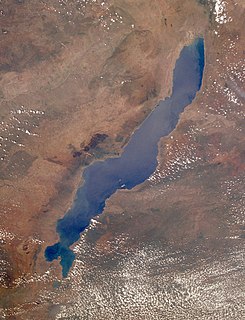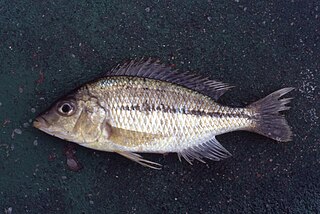
Lake Malawi, also known as Lake Nyasa in Tanzania and Lago Niassa in Mozambique, is an African Great Lake and the southernmost lake in the East African Rift system, located between Malawi, Mozambique and Tanzania.

Protomelas taeniolatus is a Haplochromine cichlid endemic to Lake Malawi in Eastern Africa. The fish is popular in the aquarium hobby due to the bright rainbow-like colors of adult males and its relatively peaceful temperament. Juvenile and female P. taeniolatus, like many Haplochromines, do not display bright coloration.

The haplochromine cichlids are a tribe of cichlids in subfamily Pseudocrenilabrinae called Haplochromini. This group includes the type genus (Haplochromis) plus a number of closely related genera such as Aulonocara, Astatotilapia, and Chilotilapia. They are endemic to eastern, southern and northern Africa, except for Astatotilapia flaviijosephi in the Middle East. A common name in a scientific context is East African cichlids – while they are not restricted to that region, they are the dominant Cichlidae there. This tribe was extensively studied by Ethelwynn Trewavas, who made major reviews in 1935 and 1989, at the beginning and at the end of her career in ichthyology. Even today, numerous new species are being described each year.

Dimidiochromis is a genus of haplochromine cichlids endemic to Lake Malawi in East Africa. All of its species are elongated in shape and predatory on smaller fishes.

Haplochromis is a ray-finned fish genus in the family Cichlidae. It has been used as the default "wastebin taxon" for Pseudocrenilabrinae cichlids of the East African Rift, and as such became the "largest" fish "genus". Many of these cichlids are popular aquarium fishes; like similar Haplochromini they are known as "haplos", "happies" or "haps" among aquarium enthusiasts.

Copadichromis borleyi is a species of haplochromine cichlid fish endemic to Lake Malawi in East Africa. The species is popular in the fishkeeping hobby where it is frequently kept in aquariums. The species has numerous common names, including redfin hap and goldfin hap.

Dimidiochromis dimidiatus, is a species of fish in the family Cichlidae. It was formerly placed in the genus Haplochromis and is known as the Ncheni type haplochromis in the aquarium fish trade.
Dimidiochromis kiwinge is a species of haplochromine cichlid which is found in Lake Malawi and Lake Malombe in Malawi, Mozambique, and Tanzania. Its natural habitat is freshwater lakes.
Eclectochromis lobochilus is a species of fish in the family Cichlidae. It is found in Malawi, Mozambique, and Tanzania. Its endemic to Lake Malawi.
Haplochromis sp. nov. "Blue Rockpicker" is a species of cichlid endemic to the Tanzanian part of Lake Victoria. Its natural habitat is freshwater lakes. This species grows to a length of 10.7 centimetres (4.2 in) SL.
Astatotilapia tweddlei is a species of fish in the family Cichlidae. It is found in Malawi and Mozambique. Its natural habitats are rivers and freshwater lakes.

The giant haplochromis is a species of cichlid endemic to Lake Malawi and Lake Malombe, preferring areas with sandy substrates and Vallisneria patches. It is an algae eater, obtaining its food by scraping it from the leaves of aquatic plants. This species grows to a length of 20 centimetres (7.9 in) TL. This fish can also be found in the aquarium trade. This species is the only known member of its genus.
Labidochromis strigatus is a species of cichlid endemic to Lake Malawi where it is only known to occur in areas with rocky substrates around Likoma Island and Chisumulu Island. This species can reach a length of 6.9 centimetres (2.7 in) SL. It can also be found in the aquarium trade.

Mylochromis melanonotus, known in the aquarium fish trade as haplochromis yellow black line, is a species of cichlid fish endemic to Lake Malawi where it is usually found over sandy substrates. This species can reach a length of 26 centimetres (10 in) TL.
Naevochromis chrysogaster is a species of cichlid endemic to Lake Malawi where it prefers areas with rocky substrates. This species has a specialized diet, feeding on the fry and larvae of other cichlids. It reaches a total length of 17.9 cm (7.0 in). This species is also seen in the aquarium trade and sometimes goes by the name Haplochromis Jack Dempsey. It is currently the only known member of the genus Naevochromis.

Protomelas kirkii is a species of cichlid endemic to Lake Malawi where it is most commonly found in areas vegetated with Vallisneria. This species can reach a length of 18 centimetres (7.1 in) TL. This species can also be found in the aquarium trade.

The electric blue hap is a species of cichlid fish endemic to Lake Malawi. It prefers to live in caves and crevices in rocky substrates. This species can reach a length of 20 centimetres (7.9 in) TL. It can also be found in the aquarium trade.
Mylochromis gracilis, known as the happy or the Haplochromis torpedo stripe, is a species of cichlid endemic to Lake Malawi where it is only known from sandy areas in the southern end of the lake. This species can reach a length of 22 centimetres (8.7 in) TL.

Trematocranus microstoma, known in the aquarium trade as the "Haplochromis placodon pointed head" is a species of cichlid endemic to Lake Malawi where it is found in shallow waters close to shore, apparently showing a preference for areas with plentiful vegetation. This species can reach a length of 23.2 centimetres (9.1 in) TL. This species can also be found in the aquarium trade.

Haplochromis vonlinnei is a species of cichlid endemic to Lake Victoria. It is greyish in color with a distinct mid-lateral band, and a rather slender shape. It feeds mainly on smaller fish. This species can reach a length of 15.9 centimetres (6.3 in) SL. The population of the species has declined due to the introduction of the Nile perch in the 1950s. It has not been recorded since 1980 and the IUCN lists it as "Critically Endangered" and considers it may already be extinct. This fish is named in honour of the Swedish naturalist, Carl Linnaeus.














